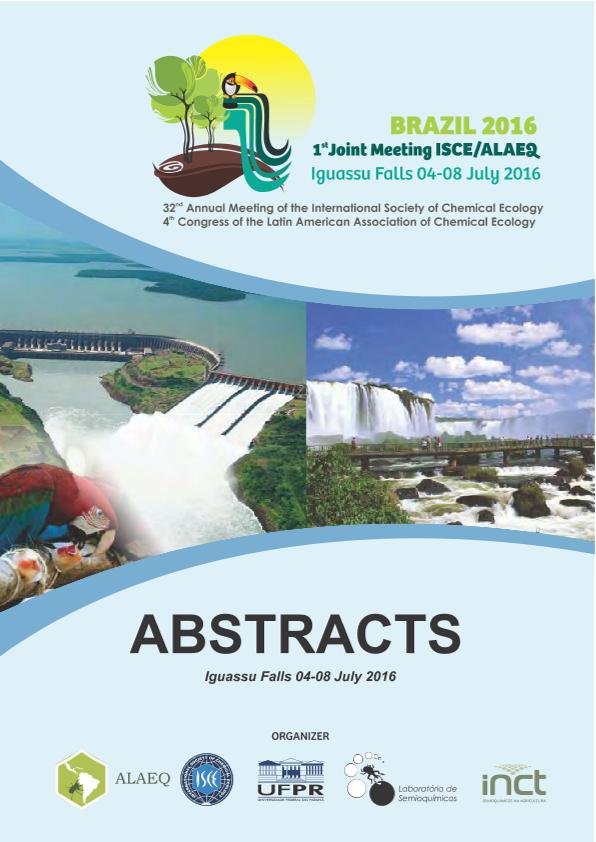Mostrar el registro sencillo del ítem
dc.contributor.author
Valladares, Gabriela Alejandra

dc.contributor.author
Braccini, Celina Laura

dc.contributor.author
Alderete, Mariela del Carmen

dc.contributor.author
Coll Araoz, Maria Victoria

dc.contributor.author
Vera, Teresa
dc.contributor.author
Fernandez, Patricia Carina

dc.date.available
2023-04-21T14:02:43Z
dc.date.issued
2016
dc.identifier.citation
Oviposition choices of the willow sawfly nematus oligospilus is affected by conspecific herbivory in the native willow salix humboldtiana.; 32nd Annual Meeting of the International Society of Chemical Ecology and 4th Congress of the Latin American Association of Chemical Ecology; Foz do Iguacu; Brasil; 2016; 1-2
dc.identifier.uri
http://hdl.handle.net/11336/194893
dc.description.abstract
Most herbivorous insects start attacking a plant by laying eggs on it. Host plant selection can be crucial for the survival of the new insect generation, especially when larvae lack mobility to select their own feeding places. The willow sawfly, Nematus oligospilus (Förster), is an exotic emerging pest in Salix commercial forests and has been reported worldwide. Females of this species are parthenogenetic in the southern hemisphere and must find and recognize their host plant when they emerge as adults.The objective of the present work was to evaluate the effect of conspecific herbivory on the oviposition choices of N. oligospilus females. Local and systemic effect, were studied. First, choice tests were conducted on Salix humboldtiana (Willdenow) and S. babylonica (Linneaus) var. sacramenta in undamaged potted plants vs. plants after 48 hs. of larval feeding. Results on S. humboldtiana, suggests strong repellence to plants with damage as females highly preferred branches from undamaged plants for oviposition. This was observed for both, local and systemic damage. For S. babylonica we did not find significant differences between treatments.In order to look for the chemical cues associated to this behavior, plant volatiles are being analyzed. Preliminary observations showed qualitative differences between the chemical composition of damaged and undamaged plants, suggesting the presence of plant cues elicited by larval feeding as oviposition repellents.
dc.format
application/pdf
dc.language.iso
eng
dc.publisher
Latin American Association of Chemical Ecology
dc.rights
info:eu-repo/semantics/openAccess
dc.rights.uri
https://creativecommons.org/licenses/by-nc-sa/2.5/ar/
dc.subject
OVIPOSITION CHOICES
dc.subject
CHEMICAL CUES
dc.subject
OVIPOSITION REPELLENTS
dc.subject.classification
Otros Tópicos Biológicos

dc.subject.classification
Ciencias Biológicas

dc.subject.classification
CIENCIAS NATURALES Y EXACTAS

dc.title
Oviposition choices of the willow sawfly nematus oligospilus is affected by conspecific herbivory in the native willow salix humboldtiana.
dc.type
info:eu-repo/semantics/publishedVersion
dc.type
info:eu-repo/semantics/conferenceObject
dc.type
info:ar-repo/semantics/documento de conferencia
dc.date.updated
2023-02-15T17:27:25Z
dc.journal.pagination
1-2
dc.journal.pais
Brasil

dc.journal.ciudad
Foz do Iguacu
dc.description.fil
Fil: Valladares, Gabriela Alejandra. Universidad Nacional de Tucuman. Facultad de Agronomia y Zootecnia. Sanidad Vegetal; Argentina. Consejo Nacional de Investigaciones Científicas y Técnicas. Centro Científico Tecnológico Conicet - Tucumán; Argentina
dc.description.fil
Fil: Braccini, Celina Laura. Instituto Nacional de Tecnología Agropecuaria; Argentina
dc.description.fil
Fil: Alderete, Mariela del Carmen. Universidad Nacional de Tucumán. Facultad de Ciencias Naturales e Instituto Miguel Lillo; Argentina. Consejo Nacional de Investigaciones Científicas y Técnicas. Centro Científico Tecnológico Conicet - Tucumán. Planta Piloto de Procesos Industriales Microbiológicos; Argentina
dc.description.fil
Fil: Coll Araoz, Maria Victoria. Consejo Nacional de Investigaciones Científicas y Técnicas. Centro Científico Tecnológico Conicet - Tucumán. Planta Piloto de Procesos Industriales Microbiológicos; Argentina
dc.description.fil
Fil: Vera, Teresa. Universidad Nacional de Tucumán. Facultad de Ciencias Naturales e Instituto Miguel Lillo; Argentina
dc.description.fil
Fil: Fernandez, Patricia Carina. Instituto Nacional de Tecnología Agropecuaria. Centro Regional Buenos Aires Norte. Estación Experimental Agropecuaria Delta del Paraná; Argentina. Consejo Nacional de Investigaciones Científicas y Técnicas; Argentina
dc.relation.alternativeid
info:eu-repo/semantics/altIdentifier/url/https://www.chemecol.org/programs/2016%20abstracts.pdf
dc.conicet.rol
Autor

dc.conicet.rol
Autor

dc.conicet.rol
Autor

dc.conicet.rol
Autor

dc.conicet.rol
Autor

dc.conicet.rol
Autor

dc.coverage
Internacional
dc.type.subtype
Reunión
dc.description.nombreEvento
32nd Annual Meeting of the International Society of Chemical Ecology and 4th Congress of the Latin American Association of Chemical Ecology
dc.date.evento
2016-06-04
dc.description.ciudadEvento
Foz do Iguacu
dc.description.paisEvento
Brasil

dc.type.publicacion
Book
dc.description.institucionOrganizadora
Latin American Association of Chemical Ecology
dc.description.institucionOrganizadora
International Society of Chemical Ecology
dc.source.libro
32nd Annual Meeting of the International Society of Chemical Ecology and 4th Congress of the Latin American Association of Chemical Ecology
dc.date.eventoHasta
2016-07-08
dc.type
Reunión
Archivos asociados
